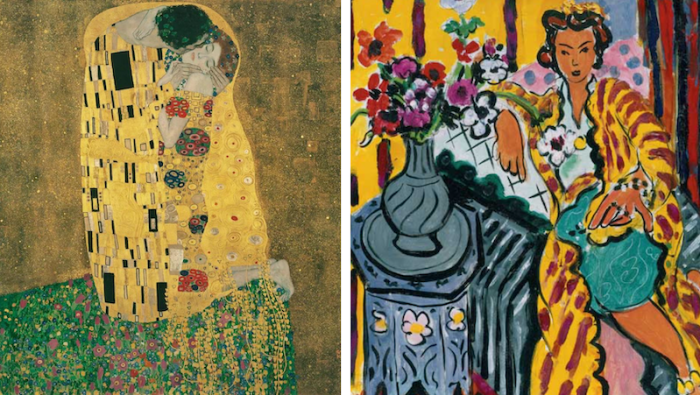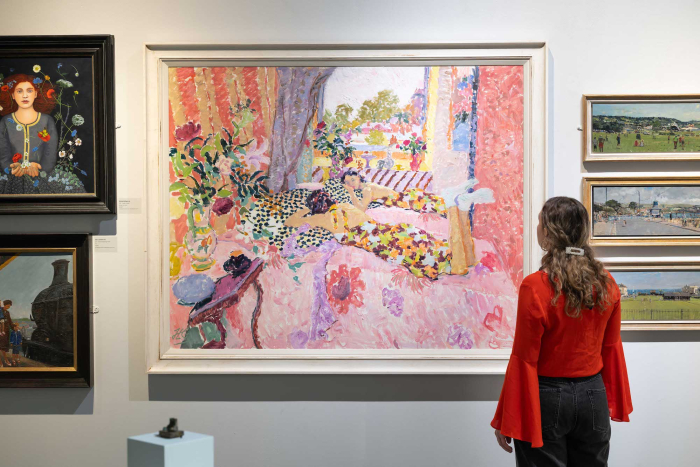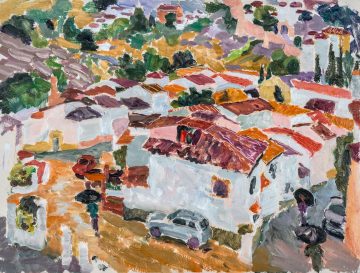Media
In Conversation – Hugo Grenville
After winning 2024’s Royal Society of British Artist award from Mall Galleries, Hugo Grenville has been featured in a 6 page spread in The Artist magazine’s January 2025 issue.
Digital copies of the full publication are still available to download, or you can take a look at the spotlight below:
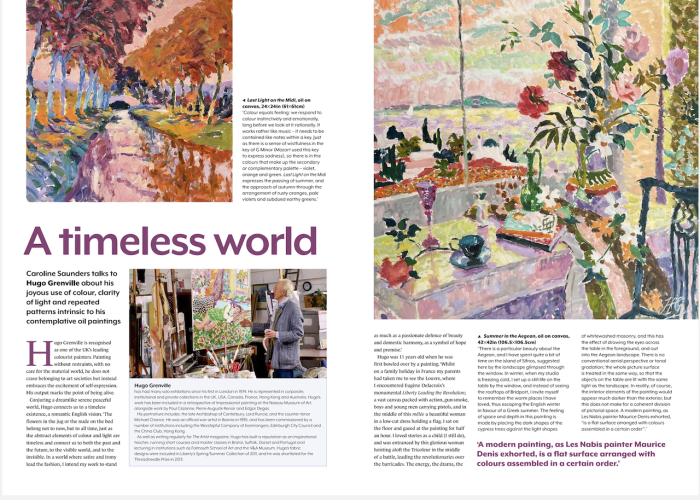
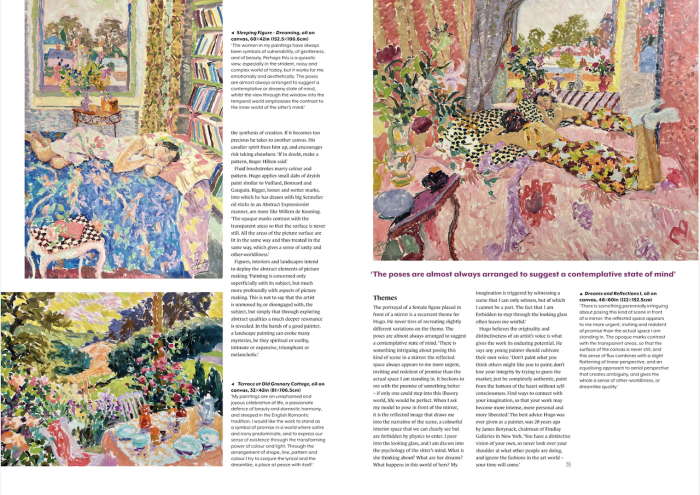

Findlay Galleries New York – October 2024
This collection is an exploration of the way in which colour influences our feelings. We live surrounded by colour, in our homes, in the landscape, and perhaps at work too, but seldom do we have time to stop and consider its effect upon us. Why does a room observed in the blue-violet light of a summer dawn suggest a very different atmosphere to the same room lit by the golden light of a summer evening? As humans, we respond to colour from an early age, preferring a red shirt to a green one or a yellow one to a pink one. Colour works like music: it instantaneously chimes with our feelings and moods. Certain combinations evoke pleasure, others distaste. In this group of new paintings, I have used colour as one might use a key in music, as a way of setting the emotional tone of a composition, of communicating something inner through the arrangement of its harmonies.
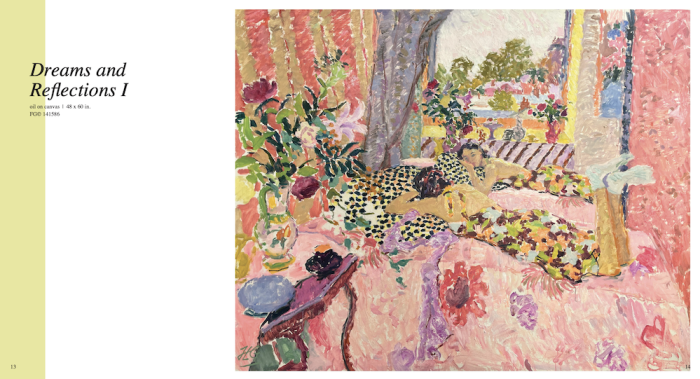
As with all my work, the paintings seek to convey a spirit of contemplation, reflection and gentle joy found in the world around us, our houses, the streets of our hometowns, and the countryside. I am much moved by looking through windows, and many of the room interiors are designed to lead the viewer’s eye through the careful arrangement of shapes and into the outside world; sometimes, this device has the effect of cloaking the ordinary in a sort of otherworldliness so that the mind can wander freely into the pastures of the imagination. There is a similar effect where a mirror is used to reflect the figure: the interior space presented to the viewer presents an alternative version of reality, a kind of dreamworld, an Alice through the Looking-Glass experience.
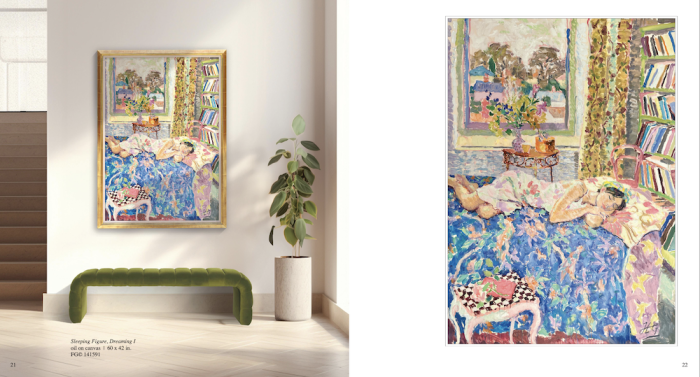
The paintings largely fall into two groups: the landscapes composed from the terrace at Old Granary Cottage, my home, and the interiors, some with figures, designed in my studio. Although my vision is rooted in the tradition of English Romanticism, the way in which the paint is deployed is influenced both by a long immersion in European Post-Impressionism and by my more recent fascination with American Post-war painting. In the bigger pictures, the juxtaposition of flat and liquid areas of translucent colour, applied in fluid broad brush marks, with shorter, thicker impasto marks, probably owes more to the technique of de Kooning than it does to Matisse, even if the subject matter remains firmly domestic.
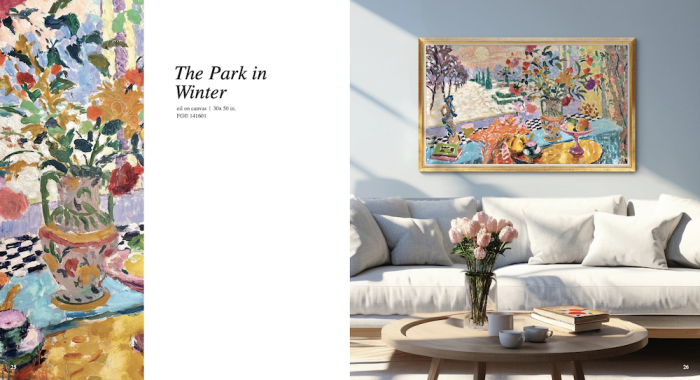
To see the catalogue visit here
A full virtual tour of the exhibition can be seen here
Royal Society of British Artists Exhibition 2024
From 29 Feb to 9 Mar 2024
The RBA Annual Exhibition gathers together the Society’s members, among the finest artists in the UK and beyond, to showcase their work alongside a selection of works by non-members, which are of the highest quality.

Interview with Hugo Grenville
Mall Galleries spoke with Hugo Grenville, an exceptionally talented artist who specialises in oil painting. Grenville masterfully creates a serene world with his collection of figure subjects and everyday objects. Through his work, he captures the very essence of joy in life, light and colour.
Can you tell me about your artistic background, what draws you to painting and your desire to visually record the world around you?
I was eleven years old when I was first bowled over by a painting. Whilst on a family holiday in France my parents had taken me to see the Louvre, where I encountered Delacroix’s monumental “Liberty Leading the Revolution”: a vast canvas packed with action, gun-smoke, boys and young men carrying pistols, and in the middle of this mêlée a beautiful woman in a low-cut dress holding a flag. I sat on the floor and gazed at the painting for half an hour. I loved stories as a child (I still do), and was entranced by this glorious woman hoisting aloft the Tricoleur in the middle of a battle, leading the revolutionaries over the barricades. The energy, the drama, the beauty of it all. I started painting at school shortly afterwards, watercolours of battle scenes, or other episodes from history, that caught my imagination. Later, as a teenager, I began painting landscapes out of doors in oil, won some school art prizes, and exhibited at the Chelsea Art Society aged 14, but it never occurred to me, or anyone in my family, that I should consider a career as an artist. So, I became first a soldier, taking my watercolours with me on operational duty to the civil war in Rhodesia (now Zimbabwe), and to the Troubles in Northern Ireland, drawing and painting whenever I had time. I became a member of the Armed Forces Art Society. After leaving the army I worked for an American advertising agency in London, before setting up a business to commission art for office buildings and hotels. On Saturdays I would set off to paint the world around me, sitting on London Street corners, and on the towpath of the Regents Park Canal, making watercolours of urban life, answering a need that I could not clearly define.

Your body of work captures the joy of life, light and colour through everyday subjects. Your piece ‘Dreams and Reflections’, featured in the RBA Annual Exhibition 2024 at Mall Galleries, embodies the modern aesthetics in the portrayal of a woman in her mirror, a theme that you have explored multiple times. Why is this theme so important to you? Are you interested in capturing vanity or maybe escapism?
The women in my paintings have always been symbols of vulnerability, of gentleness, and of beauty. Perhaps this is a Quixotic view, especially in the strident, noisy and complex world of today, but it works for me aesthetically and emotionally. The poses are almost always arranged to suggest a contemplative state of mind. There is something perennially intriguing about posing this kind of scene in a mirror: the reflected space always appears to me more urgent, inviting and redolent of promise than the actual space I am standing in. It beckons to me with the promise of something better – if only one could step into this illusory world, life would be perfect. When I ask my model to pose in front of the mirror, it is the reflected image that draws me into the narrative of the scene, a colourful interior space that we can clearly see but are forbidden by physics to enter. I peer into the looking glass, and I am drawn into the psychology of the sitter’s mind. What is she thinking about? What are her dreams? What happens in this world of hers? My imagination is triggered by witnessing a scene that I can only witness, but not be part of, as though I was watching a film, and the woman, my model, has becomes a character in this story. But the fact that I am forbidden to step through the looking glass often leaves me wistful.
We are interested in your painting technique, which reminds us of impressionist & pointillist artists such as George Seurat, whose work is characterised by small dot-like touches and flat patches of colour. How do you integrate these distinct elements to achieve the dreamlike qualities that characterise your work? Do you ever look at impressionist works, techniques and themes to find inspiration for a new piece?
If I had to define the way I apply the paint to the canvas in terms of Modern Art movements, I would say that it is essentially a fusion of Post Impressionism and Abstract Expressionism: the smaller dabs of dryish paint owe their origins to studying the work of Vuillard, Bonnard and Gauguin; the bigger, looser and wetter marks, into which I have drawn with big Sennelier oil sticks, are more a sort of borrowing from De Kooning. The opaque marks contrast with the transparent areas so that the surface is never still, and this sense of flux combines with a slight flattening of linear perspective, and an equalising approach to aerial perspective, which I call my process of democratisation; in other words, all the different areas of the picture surface are lit in the same way and thus treated in the same way, which gives the whole a sense of other-worldliness, or dreamlike quality.
Yes, I love looking at the work of the great Post Impressionist painters, and I do often find inspiration in the clarity of their visions. I am indebted to the three painters I have just mentioned above, who set me off on my path, and of course to Matisse for his glorious pattern-making, and to Klimt for his unashamed Romantic sensibility.
Photo by Mark Sepple
As an accomplished painter, what advice would you offer aspiring artists navigating their career in the art industry today?
The best advice I have ever been given as a painter was given to me 20 years ago by James Borynack, chairman of Findlay Galleries in New York: he had just signed me up to the gallery, and he patted me on the shoulder and said: “You have a distinctive vision of your own, so never look over your shoulder at what other people are doing, and ignore the fashions in the art world – your time will come”. Whether it ever comes or not, I do believe that his advice is the fundamental building block for any young painter: be yourself, and cultivate your own voice. Don’t try to paint what you think other people would like you to paint; don’t lose your integrity by trying to guess the market; just be true to yourself, paint only what you feel deeply, be completely authentic. I know the art world is a difficult place right now, and unrecognisable from when I set out as a painter in 1990, but over time the art that holds its own is work that is readily identifiable by its maker. It’s rare to look at a Matisse painting and not know that it is made by Matisse. In the end the originality and distinctiveness of an artist’s voice is what gives the work its enduring potential.
You can also visit Hugo’s home studio in West Milton, Dorset for the first time next month during Dorset Arts Week – on the weekend of Sat 25 May and Sun 26 May from 10 to 4 pm.
Directions to the studio here
For more information contact Angie Porter on 07747 758595 or email on assistant@hugogrenville.com

We live in troubling times. Chaos abounds at home, abroad there is war and repression. Some artists choose to comment on the strife and struggle they observe around them, others choose to find meaning in intimacy. In 1943, when Nazi jackboots strutted down the Promenade des Anglais in Nice, both Bonnard and Matisse, whose studios were only a few kilometres away, elected to lift their heads beyond the daily horror of the Occupation. Instead they were hard at work on a series of paintings of domestic subjects: garden scenes, still life arrangements and figure studies, explorations of glorious colour harmonies that exude a robust optimism in the face of danger and despair. Their paintings expressed a full-blooded sense of existence through the transforming power of colour and light.
Although I started out as a sort of social commentator in paint 30 years ago (David Messum once promoted me as a ‘modern day Hogarth, in the style of Sickert’) my painter’s journey has taken me, via the expressive language of French Post-Impressionism, into the rich pastures of English Romanticism. In a world where satire and irony lead the fashion, I intend my work to stand as a passionate defence of beauty and domestic harmony, as a symbol of hope and promise. The collection of paintings in this exhibition, all made over the last couple of years, share in a common a quest to conjure the lyrical and the dreamlike, to present an inner world at peace with itself. To achieve this, I have tended to work away from the subject, allowing memory and reflection to seep into the process, so that each picture is a distillation of experience, a reinvention of my imagination, rather than a straight record of a place or an arrangement of objects. By restricting the colours in my palettes to only one or two primaries and one or two secondaries, I have been able to better explore colour harmony, which seems to me to work in a similar way to the keys in music, where the greatest expressiveness is achieved within a restricted hierarchy of notes.
The pictures in this show are largely inspired by my home and garden, and by two much loved areas of countryside: the wild, romantic shoreline of the Cornish coast, and the deep sultriness of the Midi. But all the paintings here, the figure subjects, the interiors and the landscapes, have at their heart the principal intention to deploy the abstract elements of picture making. These include the arrangements of shape, colour, line, pattern, and the sense of light achieved through variation in tonal values – in the pursuit of exploring timelessness, of connecting us to time past, present and future, to both the visible world and the invisible.
“What an absolutely stunning show – a wonderful freedom, joy and clarity of light and colour; an intelligence and emotional undertone in Grenville’s figures.”
The Preview of Grenville’s London Exhibition is on Tuesday 14 March at Cricket Fine Art from 6-8pm
Links to high res pictures in the exhibition and of Hugo Grenville here https://www.artworkarchive.com/rooms/angie-321b29ff-bb38-4aeb-bb76-a5d8623d7add/15d586

NCMA Museum Hosts Masterworks by Renoir, Degas, Hassam, Grenville and Others Paintings from Greta Garbo’s Private Collection on View
March 19-July 10, 2022
Childe Hassam, Italian Day, May 1918, oil on canvas, 36 x 26 in. Art Bridges.

Impressionism is the most popular style of art worldwide, with followers around the globe. With masterworks by all the leading figures, this ravishingly beautiful show of sun-filled landscapes and colorful portraits opens at the Nassau Museum of Art in time for spring. The most beloved art movement of all time began in Paris when a bold band of painters headed by Renoir, Degas, Ce?zanne and Pissarro (all of whom are represented in the exhibition) rebelled against the tight realism of the day and the threat of photography. Spreading rapidly across Europe, Russia, Asia and the Americas, Impressionism became more than just a way of painting—it was a way of seeing that swept the world. This show combines important French originators with their Asian, European and American colleagues (including those from both forks on the East End of Long Island, a renowned colony of artists working across the Sound in Lyme, Connecticut and California). Brimming with colorful works from far and near, it also transcends time periods, starting with rare paintings by the mighty English master J.M.W. Turner (who influenced the French Impressionists) and culminating with Contemporary “Neo-Impressionists” such as Mark Innerst, Ross Bleckner, Max Kozloff and an exciting new talent, Flora Yukhnovich. It is a movement that began officially with the infamous Salon des Refuses (1874) but was prefigured by revolutionary innovations in painting pioneered by Turner as well as Courbet and others. Even today, this approach to painting is making all the difference in the way we experience the world.

Edgar Degas
Aux courses. Les Jockeys, c.1868
oil on panel, 18 1/16 x 14 9/16 inches
Courtesy Private Collection and International Art Acquisitions, Inc.
At the core of the exhibition is a dialogue between France and America. The discovery of Impressionism was a momentous shift in perception as well as art. Monet and Ce?zanne pioneered a way of rendering the light itself. Instead of attempting to depict the landscape itself, the Impressionists captured the “envelope” of air between the eye and the motif, such as a cathedral or haystack, using a loose style of brushwork typified by the comma stroke and bright patches (called “taches” by their critical advocate Felix Feneon) of pure color. In the hands of Renoir, Degas, Ce?zanne and others in the show, this profound new idea about the relationship between the painting and the world took on individual characteristics. For Renoir, it led to dreamy landscapes in a rainbow of bright tones layered one on top of each other, while Ce?zanne caught the shimmer of leaves in the wind with prismatic strokes of his pencil, charcoal or brush.
Among the many Americans who arrived in Paris to try this new technique alongside the masters were Mary Cassatt, who became a prote?ge? of Degas, and Childe Hassam, both of whom are represented in the show by major works. Many Americans made the pilgrimage to Paris and to Giverny, including Theodore Robinson, Ernest Lawson, William Merritt Chase and Paul Cornoyer, whose views of France are among the most inspiring paintings in the show.
Meanwhile, colonies of artists who were dedicated to the movement began to emerge in the United States, including tight-knit groups in the Hamptons (where Chase taught in Shinnecock) on the North Fork (in Southold, where Henry and Edith Prellwitz had side-by-side studios overlooking Peconic Bay) and overlooking the Sound in Lyme, Connecticut. Several works are in the show made by these artists who painted outdoors in picturesque spots that are often still frequented by painters today and retain the luminous natural beauty that drew earlier generations.
In England, one of the most eloquent champions of the Impressionist way of painting was Roger Fry, a writer who was part of the amazing Bloomsbury group of intellectuals who lived, loved and worked together in London and at Charleston, a country house in Sussex. Impressionist painter Vanessa Bell and her sister, literary superstar Virginia Woolf, joined other renowned figures in the Bloomsbury group, including the economist John Maynard Keynes and his wife Lydia Lopokova, an internationally renowned ballerina. The exhibition includes a gallery devoted to paintings and drawings by Fry, Bell and her husband Duncan Grant (including studies for the ballets he designed).
A contemporary English artist who was influenced by both Bell and Fry is Hugo Grenville. His work marry colour and pattern in an impressionist style. A feeling of intimacy in his work connects him to Cezanne and Degas. His inspirational paintings are an unashamed and joyous celebration of life, steeped in the English Romantic tradition.
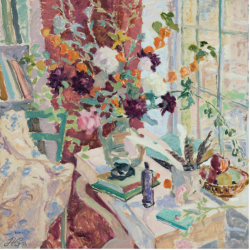
Hugo Grenville
The Window in Winter.
Oil on canvas
42 x 42 inches
Courtesy of Wally Findlay Fine Art, New York

Theodore Robinson
River Seine at Boissise-la-Bertrand, n.d.
Oil on canvas
12 x 18 inches
Courtesy of Mark Murray Fine Paintings, New York
Bloomsbury group in Sussex
The exhibition also includes several important museum loans, including a prized seascape by Johan Jongkind (an early influence on Monet) from the permanent collection of Hofstra University and a stunning cityscape by Childe Hassam that is a highlight of the renowned Crystal Bridges Museum in Bentonville, Arkansas. Provenance is an exciting part of the show, which includes one of Greta Garbo’s favorite paintings, a landscape by Andre Lhote which for decades was a centerpiece of her Manhattan apartment’s brightly colored de?cor (Lhote had been the teacher of Garbo’s brother).

Because Impressionism was a way of understanding the world that transcended both borders and time periods, the exhibition moves into our own time with a selection of works by important Contemporary artists, including recent work by Ross Bleckner, Mark Innerst, Max Kozloff, Jane Wilson and others.

Mark Innerst, Gateway, 2014, oil on panel in the artist’s handmade frame, 20 x 16 in.,
25 x 21 in. (framed), Courtesy of the artist and DC Moore Gallery, New York (c) Courtesy of the artist and DC Moore Gallery, New York
The exhibition will be accompanied by a full-color catalogue and programs that include lectures, artist talks, orchestral and chamber concerts featuring the works of composers such as Debussy and Faure (who were associated with French Impressionism) and our popular artists in the galleries series featuring the Contemporary painters in the show.
About the Museum
Nassau County Museum of Art is located at One Museum Drive in Roslyn Harbor. The museum is open Tuesday-Sunday, 11 a.m.-4:45 p.m. Admission is $15 for adults, $10 for seniors (62 and above) and $5 for students and children (4 to12). Docent-led tours of the exhibition are offered at 2 p.m. each day; tours of the mansion are offered each Saturday at 1 p.m.
Hugo Grenville, a life in colour is an intimate documentary that unveils the captivating world of Hugo Grenville, a visionary contemporary painter based in the picturesque town of Bridport, England. With a romantic flair that defines his artistic style, Hugo invites viewers into his studio, providing a rare glimpse into the mind of an artist deeply connected to his craft. Through a series of interviews, we explore the profound meanings behind his art, unraveling the layers of emotion, inspiration, and spirituality that infuse each brushstroke. Hugo's canvases become windows into his soul, reflecting not only his mastery of technique but also his philosophy on the beauty inherent in every moment. As the documentary unfolds, we follow the trajectory of Hugo's artistic journey, discovering the challenges and triumphs that have shaped his career. Despite the undeniable talent that permeates his work, we learn that Hugo's path as an artist has been far from straightforward. The film artfully navigates through the highs and lows of his career, shedding light on the resilience and passion required to thrive in the demanding world of contemporary art.

The history of western art during crisis and war. Contextualised in centuries of European conflict, Grenville looks at how the experience of war can influence an artist and their art. He includes some of the most famous depictions of war in painting and their impact on western art.
Britain’s Leading Impressionist Painter joins Degas and Monet at the NCMA in the US

The exhibition takes you around the world to Poland, Vietnam, Venice, England and New York City. Hugo Grenville is part of this world showcase of Impressionist masterworks.
Picture of the Month: September 2021

Rêvereuse: At the centre of the painting the model sleeps amongst a riot of colour and pattern.
Hugo Grenville talks with Jo Wright of Lyme Bay Radio Arts Cafe
Hugo discusses his artistic influences and his unconventional route to becoming an artist, he also shares some of his favorite musical inspiration.
Hugo takes you through the making of a figure painting from start to finish. June 2020



